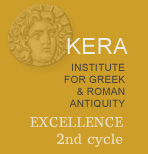Main Site . Other insciptions from the main site of Boubon
5 |
Αματα καὶ Ἀρ– τέμων καὶ Μο– λεσις καὶ Ἐλεύ– θερος καὶ Ἑρμαῖ– ος Ἐλευθέρῳ Ἀρτέμωνος τοῦ Ἑρμαίου τῷ πατρὶ φιλοστοργίας καὶ μνήμης ἕνεκεν. |
Amata, Artemon, Molesis, Eleutheros and Hermaios, for the love and memory of their father Eleutheros, son of Artemon, grandson of Hermaios.
Round funerary column, found and documented by Kalinka in Boubon in 1895. The stone has not been rediscovered since.
Height: 102 cm; diameter: 48 cm; letters: 3-4 cm.
Heberdey and Kalinka 1897, no. 47; Schindler 1972, no. 30 (pl. 5.25 reproduces a drawing by an unknown scholar); BullÉp 1973, no. 461; Milner 1998, p. 3, no. 1.35.
L. 1-2 : Αματα: TAM II 748 (Nisa, northern Lycia); MAMA 7 554 (Galatia); SEG 6 (1932), no. 423 (Ikonion, Lycaonia); Paribeni and Romanelli 1914, p. 174 (Sala, Pisidia). If this name originates in the perfect participle of the Latin verb amo (I love; amatus loved), it will be the only name of Latin origin in this family and, in fact, only the third such name in the inscriptions surviving from Boubon (see no. 54 with a Πία and no. 70 with a Λούκιος). Therefore Schindler 1972, p. 60, followed by Robert (in BullÉp), thinks a native origin more likely instead.
Ἀρτέμων: see no. 5.
L. 2-5 : Μόλεσις: see no. 72. Ἐλεύθερος: in Greece the name is known from Attica and the Peloponnese, and occurs a few times also in the Aegean islands. A rather limited number of examples seems more or less equally distributed in Asia Minor. In Lycia cf. TAM II 176 (Sidyma; the name belongs to a freedman); 260 (Pydnai); 332 (Xanthos); 482 (Patara); 604 (Tlos); Petersen and Luschan 1889 p. 56, no. 105 (Teimiousa). In Pisidia cf. TAM III 225; 430 (both Termessos). Schindler (ibid.), presumes the name to be derived from the native Lycian godess θεὰ Ἐλευθέρα, but there is no evidence to support this opinion; cf. BullÉp 1973, no. 461. ῾Ερμαῖος: see no. 71.

